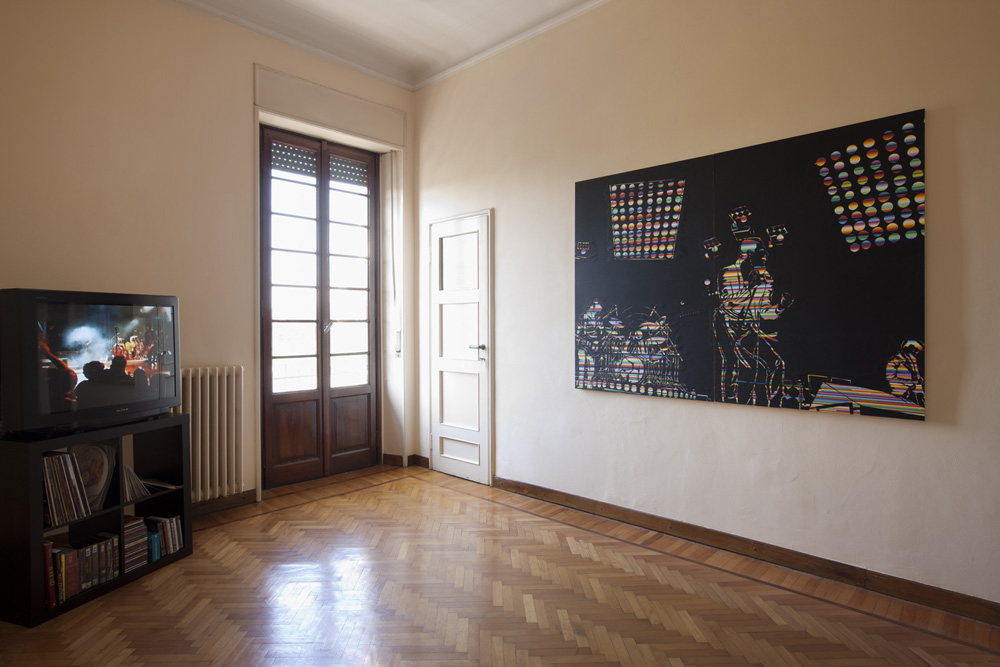Andrea Mastrovito
The Band Queen has always been a landmark for everything I did. I discovered them 20 years ago, as almost everybody, when Freddie Mercury died. My high school teacher used to teach us english making us listen Innuendo. For the first time I understood what was said in a song… thus is natural that they often come out in my works. I mean, an artist has to talk through what he knows, feels and loves/hates, in his works, and fairly why we should untie ourself from purely consumerist areas while we are totally surrounded by them? The first video works on Queen born exactly from a meditation about the concept of myth, star and on his possibility of “Technological reproducibility”, paraphrasing Walter Benjamin. So it has been natural to take the band I knew better for having collected its stuff for all the years of my youth. The first step was Sburzum & Zizi Live in Budapest ’86, where, making an accurate assembly and disassembly work of sequenze taken from Queen Live in Budapest ’86, I could make Zizi sing with Freddie Mercury – that, among other things, heralds “tonight, for the first time, we are going to sing a new song, a special one, for you all…” reading the song’s lyric written on his hand – a ballad composed by me and my group, the Madhush, reversing the usual canons for which boy bands are covering more famous bands’ pieces.
In the two next works, specially in The Freddie Mercury Photocopied Concert, what is being unhinged is the concept itself of originality of the hic and nunc event, of the concert video, of the artist-audience oneway relationship, and all that just by the “photocopied concert”. Photocopying concerts is actually pretty easy: you take the original DVD of the event, you patiently stay in front of your computer and extrapolate every frame where all the musicians appear clearly, the singer, the instruments, etc. At this point, with a photo-retouch program every frame is increased to life size, divided in small, identical sections and printed one by one in (colour) copy format. Now, with the help of scissors and scotch tape, costumes, faces, instruments and microphones of the actual concert’s protagonists are recomposed and, once that they are worn, the concert is reinterpreted, spreading the music playback directly from the original DVD. And everything is recordered by the audience with a variety of channel, from the video camera to the photo camera to the iPhone, exactly like real concerts. The achieved result allows us to break, temporarily live and depending on the shots in the last film, the boundary between facts and fictions, bringing back to life – in the real world – just with some paper, something that is no longer alive, but in analog or digital shots; and at the same time, this result shows the scene fiction’s boundaries, because the photocopies are covering the onlookers only frontally, and so the disbielif’s suspention is never complete and continuous, but it shows the king naked at each movement. Under the television that constantly broadcasts music and video – photocopied – of Queen, there is a piece of furniture containing my CDs and books about this topic, as it was reproducing a young fan’s bedroom, and it serves as link between the two big mirror works on the wall, both made with the same matrix, one by felt-tip pens and the other by collage. In this pair of photocopies I focus my attention to Freddie Mercury’s histrionic homosexuality, underlining it just using the colours of the rainbow. His way of living homosexuality was deeply different from Testori’s one, who considered it as a sin. Nonetheless Giovanni Testori himself was a big fan of Queen, enough to make Bohemian Rhapsody jangles in all the rooms surrounding his one, in his last days of life, choosing it as viaticum for afterlife. That’s why Queen’s room is exactly located between the room of his youth and the one of his maturity.


